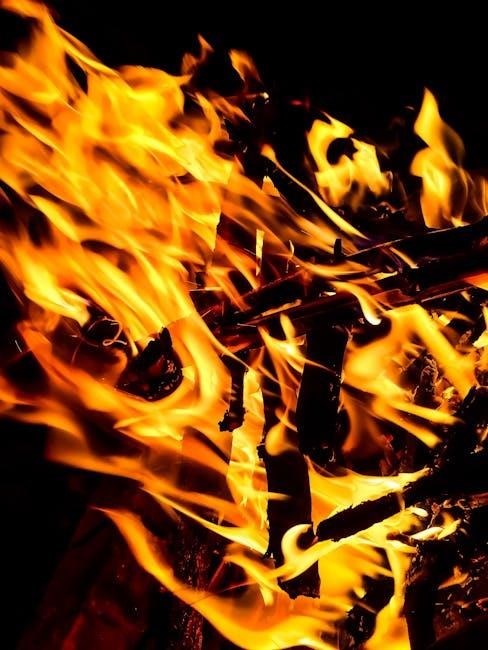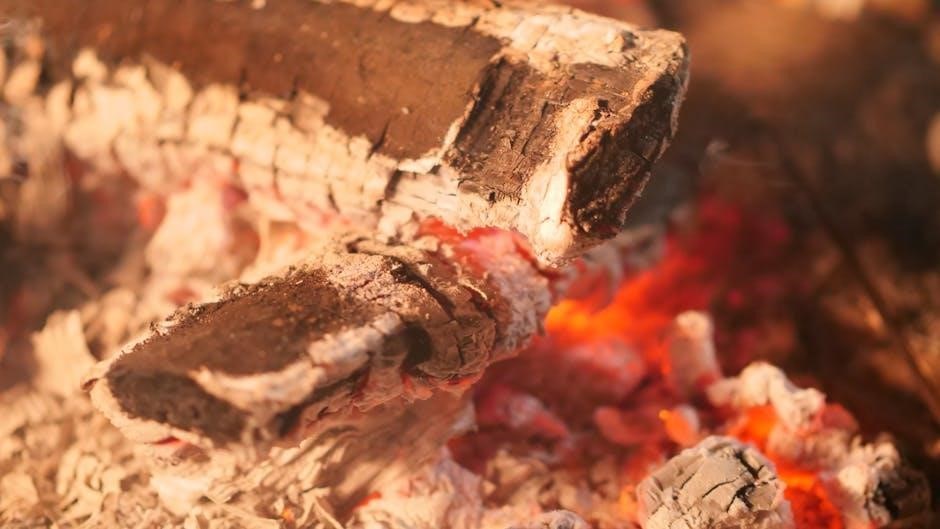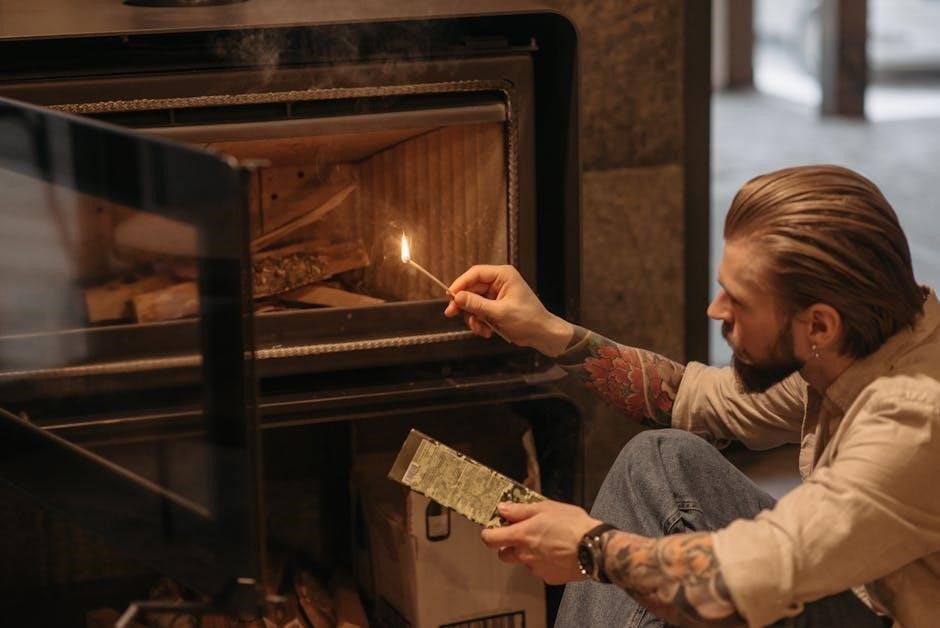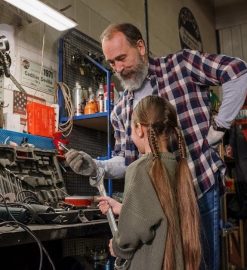heatilator wood burning fireplace manual

Welcome to the Heatilator Wood Burning Fireplace Manual. This guide provides essential information for safe installation, efficient operation, and proper maintenance of your fireplace, ensuring optimal performance and environmental stewardship.
Overview of Heatilator Wood Burning Fireplaces
Heatilator wood burning fireplaces are renowned for their durability, efficiency, and aesthetic appeal. With a legacy spanning over 90 years, Heatilator offers a wide range of models, including RH-36 and HST-48D, designed to provide warmth and ambiance while minimizing environmental impact. These fireplaces are built to deliver consistent performance, ensuring safe and efficient combustion. Proper installation and maintenance are key to optimizing their functionality and longevity, making them a reliable choice for homeowners seeking a traditional wood-burning experience.
Importance of Reading the Manual
Reading the Heatilator Wood Burning Fireplace Manual is crucial for safe installation, operation, and maintenance. It provides detailed guidelines to ensure optimal performance, prevent hazards, and comply with safety standards. The manual covers essential topics like proper fuel usage, venting requirements, and troubleshooting. By following the instructions, you can avoid common issues such as creosote buildup and inefficient combustion, ensuring a safe and environmentally friendly experience. It also includes warranty information and maintenance tips to extend the fireplace’s lifespan.
Installation Requirements
Ensure proper installation by following local building codes, venting guidelines, and manufacturer instructions. A pre-installation checklist and compliance with safety standards are essential for a safe setup.
Pre-Installation Checklist
A pre-installation checklist is crucial to ensure a safe and compliant setup. Verify local building codes, venting requirements, and chimney compatibility. Ensure all materials and tools are ready, and clearances from combustible materials are met. Check for any obstructions in the installation area and confirm proper electrical connections if applicable. Consult professionals if unsure about any step to avoid potential hazards and ensure adherence to manufacturer guidelines.
Venting and Chimney Requirements
Proper venting is critical for safe and efficient operation. Ensure the chimney flue size matches the fireplace specifications and is constructed from approved, heat-resistant materials. Maintain required clearances from combustible materials and ensure the chimney is properly insulated. Regular inspections and cleaning are essential to prevent creosote buildup and ensure optimal airflow. Always follow manufacturer guidelines for venting configurations to guarantee safety and compliance with local regulations.
Local Building Codes and Regulations
Adherence to local building codes and regulations is mandatory for safe installation and operation of your Heatilator wood burning fireplace. Ensure all permits are obtained and inspections are completed by certified professionals. These codes address venting, clearance requirements, and construction materials to meet safety and environmental standards. Always consult local authorities to confirm compliance, as regulations may vary by region to ensure public safety and environmental protection.

Operating the Fireplace
Learn how to safely and efficiently operate your Heatilator wood burning fireplace. Proper techniques ensure a consistent fire, optimal heat output, and reduced emissions for better performance.
Starting a Fire: Best Practices
Starting a fire in your Heatilator wood burning fireplace begins with choosing well-seasoned wood. Arrange tinder, kindling, and larger logs to ensure proper airflow. Light the fire at the base, using a fire starter or matches. Adjust damper settings to optimize airflow and combustion efficiency. Monitor the fire’s progress, ensuring it burns cleanly and safely. Always keep flammable materials away from the fireplace, and never burn wet or green wood, as it can produce excessive smoke and creosote buildup.
Adjusting Burn Rates and Airflow
To optimize your Heatilator wood burning fireplace’s performance, adjust the damper and primary air control to regulate burn rates. Open the damper fully for startup, then reduce it once the fire is established. Use the airflow controls to manage flame size and intensity. Monitor the fire to ensure complete combustion, minimizing emissions and creosote buildup. Avoid overloading the fireplace, as this can restrict airflow and reduce efficiency. Proper airflow adjustments ensure a cleaner, more efficient burn.
Monitoring Temperature and Smoke Levels
Monitor your Heatilator fireplace’s temperature and smoke levels to ensure safe and efficient operation. Use a thermometer to track flue temperatures, avoiding excessive heat that could damage the chimney. Keep the glass doors clean to observe flames and smoke patterns. Proper airflow ensures complete combustion, reducing smoke and creosote buildup. Excessive smoke may indicate poor ventilation or unseasoned wood. Always ensure the chimney is clear and functioning properly.

Safety Precautions
Always keep flammable materials away from the fireplace. Ensure proper ventilation to prevent carbon monoxide buildup. Supervise children and pets near the fireplace. Never touch hot surfaces or glass doors until cooled. Use seasoned wood to minimize creosote accumulation. Refer to the manual for specific safety guidelines and precautions.
Protecting People and Property
Ensure a safe distance from flammable materials and use protective barriers around the fireplace. Install a spark guard to prevent embers from escaping. Regularly inspect the chimney for damage or blockages. Keep children and pets away during operation. Never leave a burning fire unattended. Store firewood and kindling in a dry, secure location away from the fireplace. Use hearth rugs or mats to contain sparks and embers effectively.
Preventing Creosote Buildup
Prevent creosote buildup by burning seasoned, dry wood with low moisture content. Avoid burning wet or green wood, as it releases more creosote vapors. Ensure proper airflow and regular chimney inspections. Clean the fireplace and chimney annually to remove soot and creosote. Maintain a consistent burn rate and avoid slow, smoldering fires, which contribute to buildup. Regular maintenance ensures a safer and more efficient fireplace operation.
Handling Hot Surfaces Safely
Always exercise caution when interacting with your fireplace’s hot surfaces. Glass doors, metal screens, and surrounding areas remain hot long after the fire has been extinguished. Avoid touching these surfaces to prevent burns. Use protective gloves or oven mitts when handling hot components. Keep children and pets away from the fireplace during and after use. Allow surfaces to cool completely before cleaning or maintenance. Never leave hot surfaces unattended, especially when children are present.
Maintenance and Upkeep
Regular maintenance ensures optimal performance and safety. Clean the fireplace and chimney annually, inspect for wear, and replace damaged parts promptly to maintain efficiency and safety.

Cleaning the Fireplace and Chimney
Regular cleaning is essential for safety and efficiency. Clean glass surfaces within 3-4 hours of use with a non-abrasive cleaner. Inspect and remove creosote buildup in the chimney annually. Always let surfaces cool before cleaning to avoid burns. Ensure the firebox and flue are free from soot and debris. Professional inspections are recommended to maintain proper function and safety standards.
Inspecting for Damage or Wear
Inspect your fireplace and chimney annually for damage or wear. Check glass doors for cracks and ensure metal components are free from rust or corrosion. Examine the chimney flue and liner for damage or creosote buildup. Look for signs of wear in the firebox and damper. Addressing issues promptly ensures safety and efficiency. Professional inspections are recommended to identify hidden problems and maintain optimal performance.
Replacing Parts and Accessories
Regularly replace worn or damaged parts to ensure optimal performance and safety. Use genuine Heatilator parts for compatibility and reliability. Replace glass doors, igniter systems, or damaged refractory panels as needed. Always consult the manual for specific instructions. Consider professional assistance for complex replacements to avoid installation errors. Keep records of replacements for warranty purposes and future reference. Ensure all replacements meet safety and efficiency standards to maintain your fireplace’s performance and longevity.
Troubleshooting Common Issues
Identify and resolve common fireplace issues like inconsistent flames, smoke backup, or ignition problems. Refer to diagnostic guides for solutions, ensuring proper ventilation and maintenance.
Identifying and Solving Draft Problems
Draft issues often stem from improper venting or blockages. Ensure your chimney is clear of debris and creosote. Check for damaged or improperly installed venting components. Adjust the damper to optimize airflow. If problems persist, consult professional chimney sweeps to diagnose and resolve issues, ensuring a safe and efficient burn. Regular maintenance is key to preventing draft-related problems.
Addressing Smoke Backup or Leakage
Smoke backup or leakage can occur due to blockages, improper venting, or negative pressure. Inspect the chimney for obstructions like creosote or debris. Ensure the flue is properly sized and installed. Check for damaged gaskets or door seals. If issues persist, consult a professional to assess and repair any leaks or venting problems, ensuring safe and efficient operation of your fireplace.
Fixing Ignition or Burning Difficulties
Ignition or burning difficulties often stem from moisture in wood, poor airflow, or creosote buildup. Ensure wood is seasoned and dry. Check vents and dampers for blockages. Clean the chimney and flue regularly to remove creosote. If issues persist, inspect the firebox and igniter for damage. Refer to your manual for specific troubleshooting steps or consult a professional to restore optimal burning performance and safety.

Environmental Considerations
Heatilator fireplaces are designed with eco-friendly features to minimize emissions. Burning seasoned wood reduces environmental impact, while proper chimney maintenance ensures efficient combustion and lower smoke output.
Emissions and Efficiency Standards
Heatilator wood burning fireplaces are designed to meet strict EPA emissions standards, ensuring eco-friendly performance. These fireplaces feature advanced combustion technologies to maximize fuel efficiency while minimizing smoke and harmful emissions. Proper installation and maintenance, along with burning seasoned wood, are crucial for optimal efficiency. Always follow local regulations and guidelines to ensure compliance with environmental standards. Regular inspections and cleanings can further enhance performance and reduce ecological impact.
Burning Seasoned vs. Green Wood
Burning seasoned wood is highly recommended for your Heatilator fireplace, as it contains less moisture, burns more efficiently, and produces less smoke. Green wood, which is freshly cut and not dried, burns poorly, releases more creosote, and can lead to chimney buildup. Always use wood that has been properly seasoned for at least six months to ensure optimal performance, reduce emissions, and maintain fireplace longevity. Seasoned wood is essential for a safer, cleaner, and more efficient burn.
Reducing Environmental Impact
Burning seasoned wood in your Heatilator fireplace minimizes environmental impact by reducing emissions and creosote buildup. Seasoned wood burns cleaner, producing less smoke and pollutants. Ensuring complete combustion helps lower harmful emissions. Regular maintenance, like cleaning the chimney and inspecting components, optimizes efficiency and reduces environmental footprint. Adhering to local emissions standards further supports eco-friendly fireplace operation.

Warranty and Support
Heatilator fireplaces come with a manufacturer’s warranty covering parts and labor for specified periods. Dedicated customer support and online resources are available for troubleshooting and assistance.
Understanding the Manufacturer’s Warranty
Heatilator wood burning fireplaces are backed by a comprehensive manufacturer’s warranty, covering parts and labor for defects in materials and workmanship. The warranty period varies by component, with key parts like the firebox and heat exchanger typically covered for longer durations. Proper installation and maintenance are required to maintain warranty validity. Registering your product ensures full coverage and streamlined support. Refer to the manual for detailed terms and conditions.
Customer Support and Service Options
Heatilator offers dedicated customer support to ensure your wood burning fireplace operates smoothly. Resources include downloadable manuals, a detailed FAQ section, and video tutorials. For personalized assistance, contact their support team via phone or online inquiry. Registered products receive priority service, and local dealers provide expert guidance. Heatilator’s commitment to customer satisfaction ensures reliable support for any questions or concerns about your fireplace.
Final Tips for Optimal Performance
For optimal performance, ensure your Heatilator wood burning fireplace is installed by a certified professional. Use only seasoned, dry wood to minimize creosote buildup and enhance efficiency. Regularly inspect and clean the chimney, and schedule annual maintenance with a qualified technician. Keep flammable materials away from the fireplace and never leave burning fires unattended. Store firewood properly and maintain a safe clearance around the unit. Always refer to the manual for specific guidelines and adhere to local building codes.

Resources for Further Assistance
For additional support, visit the official Heatilator website to download product manuals, installation guides, and troubleshooting tips. Their FAQ section offers detailed answers to common questions; You can also contact Heatilator’s customer service team for personalized assistance or locate an authorized dealer for expert advice and maintenance services. Ensure to reference the manual for model-specific instructions and safety guidelines.



Leave a Reply
You must be logged in to post a comment.